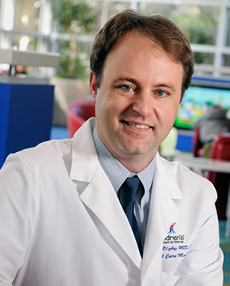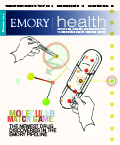Life-changing diagnosis

Landon Hosea controls his diabetes by carefully monitoring glucose levels, allowing him to enjoy activities like jamming with his dad.
by Robin Tricoles
Targeting a drug originally designed to treat psoriasis, Emory investigators are searching for a way to reverse type 1 diabetes.
Emory pediatrician Mark Rigby is often the first person to see families like the Hoseas (above) after they learn that their child has diabetes. That’s because once children reach Rigby in the pediatric intensive care unit at Children’s Healthcare of Atlanta, they are often very, very ill. They can have life-threatening dehydration, an altered consciousness, and/or severe metabolic abnormalities.
After the acute shock, equally sobering is the realization that the family’s life will never be the same. “A diagnosis of diabetes means the life the child and the family knew is gone,” Rigby says.
|
|
From that day forward, children will require an insulin shot perhaps several times a day. To keep blood glucose levels within a healthy range, they will need to check their sugar levels throughout the day and record everything they eat. They’ll even need to note current and anticipated physical activity so that carbohydrate intake and insulin can be adjusted to fit the body’s needs. Last, and just as important, a diabetes diagnosis means making sure that insulin is always at hand whether via syringe, pen, or pump.
Early on, type 1 diabetes often goes unrecognized because the children who have it usually appear healthy and fit. “Even after kids are diagnosed, you would never guess that they’re carrying around insulin shots, sugar, and a glucometer in their backpacks,” says Rigby, “or that they have to go into a bathroom before lunch and prick their finger to measure their sugar before they eat.”
One family’s story
For Landon Hosea, 12, the symptoms of diabetes first appeared late last summer after a vigorous tennis game. They continued during a family trip to Florida. Familiar with the warning signs of type I diabetes, Landon’s parents, Laurie and David Hosea, suspected that their son might have the disease. They got confirmation not long after returning to Atlanta, where Landon was hospitalized and his diabetes subsequently diagnosed.
“When you get the diagnosis, it’s pretty traumatic,” says David Hosea. “You go through a crash course to deal with this.”
The biggest adjustment for the Hoseas was staying vigilant about monitoring Landon’s carbohydrate intake and teaching their son to keep track of the count—not as easy as it might sound. Carbohydrates are the body’s main source of energy, and tracking carbohydrates in children is trickier than in adults because the kids are still growing.
David Hosea learned to be aware of the carbohydrates that Landon consumed without necessarily limiting them, allowing his son to consume calories needed for activities and growth. Landon is both active and growing. During a recent family ski trip to Colorado, he spent most of his time ski jumping, his favorite part of the sport.
Another detail the family absorbed early on was to take blood for glucose monitoring only from the fingertips of Landon’s right hand. The fingers on his left hand, he will tell you, are reserved for playing the guitar.
Putting diabetes in the corner pocket: The Hosea parents have tackled their son Landon’s diabetes together. By helping Landon keep track of carbohydrate intake, they insure he gets enough energy to keep growing. |
|||
Much in common
Although not apparent from how it presents or traditionally is managed, type 1 diabetes bears a striking resemblance to other diseases such as lupus, Crohn’s disease, rheumatoid arthritis, psoriasis, and multiple sclerosis. All of these illnesses are autoimmune diseases. “In all of those diseases, the immune system attacks various parts of the body,” says Rigby, “whether the joints in rheumatoid arthritis, the kidneys and blood vessels in lupus, the central nervous system in multiple sclerosis, or the gastrointestinal tract in Crohn’s disease. Basically for every bodily system, there’s an associated autoimmune disease.”
Because of the common characteristics of autoimmune diseases, science has seen an explosion—“a good explosion,” says Rigby—in understanding how the immune system works. Crosscutting research has allowed development of drugs that attack specific targets without triggering system-wide immune suppression. The specificity of these drugs helps prevent untoward infections, and they are less toxic to the kidneys, liver, and nervous system than older drugs.
What’s more, researchers now know that if a person suffers from an autoimmune disorder, family members are at higher risk for an autoimmune disorder. “If there’s a family member who has type 1 diabetes, there is a 20% chance that another family member has another autoimmune disease, such as celiac or thyroid disease,” says Rigby, who is part of the newly named Emory-Children’s Pediatric Research Center and whose own research overlaps with transplant research.
Organ rejection occurs when the body’s immune system attacks the transplanted organ because the body perceives it to be foreign, not unlike a damaging bacteria or virus. “It seems clear that the processes that cause organ rejection also participate in autoimmunity, specifically type 1 diabetes,” says Rigby. “It stands to reason that if we can find drugs to slow or prevent transplant rejection, the same drugs may be useful in autoimmune disorders such as type 1 diabetes.”
Through fundamental basic science research on immune cells, scientists are now developing drugs to specifically target the most destructive cells in organ transplant and autoimmunity. Many of these appear to be well tolerated with minimal side effects. In fact, they are so promising that scientists can begin to evaluate them in patients with type 1 diabetes to try to reverse the condition.
T cells run amuck
In 2003, the FDA approved the immunosuppressant drug alefacept for treatment of another autoimmune disorder, psoriasis. Since then, researchers have learned more about how the drug works. They now know that alefacept attacks a certain subpopulation of renegade T cells.
T cells function to help fight infection. In psoriasis, however, misguided T cells attack the skin, causing lesions and scaling. In diabetes, similar T cells destroy beta cells, the insulin-producing cells that reside in the pancreas. And in those with a transplanted organ, T cells are largely responsible for organ rejection.
Rigby is leading a multi-site clinical trial to study the effectiveness of alefacept in controlling type 1 diabetes. It includes 66 participants across the country, ranging in age from 12 to 35. About 80% to 90% of people who develop type 1 diabetes fall within the pediatric age range.
The researchers are hoping that alefacept, administered via weekly shots, will kill or deactivate the overactive “killer” T cells in the pancreas. “For the most part, T cells are exquisitely important for protective immunity from viruses and bacteria, even involved with cancer surveillance,” Rigby says. “But in this case, they are doing harm, lots of harm.”
The investigators hope to provide a balance by targeting overactive T cells and either deactivating or eliminating them. “With alefacept, we’re trying to deplete or deactivate the bad actor T cells in the pancreas and in the process rescue the beta cells from further destruction,” Rigby says. “Then we may be able to reset the balance by retaining protective T cells.
“An additional possible outcome would be that this approach re-educates the aberrant immune system so that when we stop the medicine, any residual misguided T cells are kept in check by the body’s natural mechanisms and don’t return to destroy beta cells.”
Meanwhile, participants in the study continue to manage their diabetes normally. However, if they find their sugar level is normal, they may hold off on taking their insulin or take a reduced dose.
“We’re hopeful about this trial because a significant number of people with psoriasis have experienced long-term remissions with alefacept,” says Rigby. “We want something analogous with diabetes.” —EH
Supporting playerIn addition to drug trials like the one described here, Emory is pursuing other research avenues to find a cure for diabetes, including islet transplantation. Much of Emory’s progress in understanding and reversing type 1 diabetes through both autoimmune and transplant studies has been supported by the Juvenile Diabetes Research Foundation (JDRF). In fact, since 2002, the JDRF has given more than $19.7 million to Emory to search for a cure. Web Connection: To see a video about islet transplantation, visit whsc.emory.edu/soundscience/archives/larsen.html. To learn more about the JDRF, visit jdrf.org. |
|||


 Pediatrician Mark Rigby
Pediatrician Mark Rigby 

